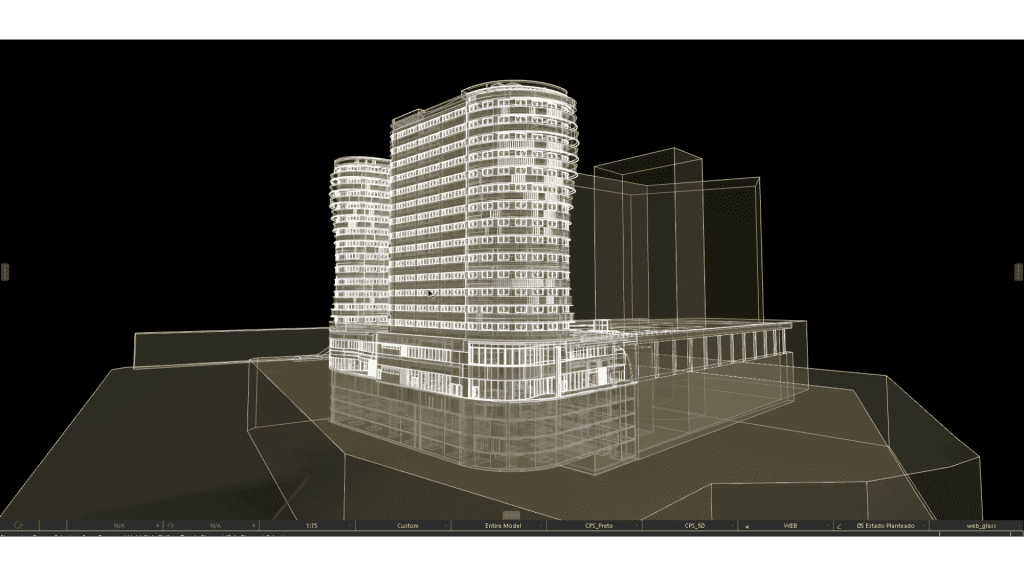BUILDERS
BIM MODELING
survey, project, scan
BIM modeling offers builders a range of benefits, resulting in more efficient, high-quality construction projects with reduced risk of issues during construction and throughout the building’s lifecycle.
- Detailed review of BIM models.
- Verification of the structure of the models and the relationships between the elements.
- Compliance with interoperability norms and standards.
- Evaluation of consistency and accuracy of data in models.
- Analysis of compatibility and interoperability of models with other software.
- Verification of regulatory and legal compliance of models.
- Evaluation of the visual and aesthetic quality of the models.
- Elaboration of audit reports with observations, nonconformities and recommendations.

- Better project visualization;
- Efficient collaboration;
- Early clash detection; More precise planning;
- More accurate cost estimates;
- Improved safety and efficient management of changes and maintenance;
- Detailed review of BIM models.
- Verification of the structure of the models and the relationships between the elements.
- Compliance with interoperability norms and standards.
- Evaluation of consistency and accuracy of data in models.
- Analysis of compatibility and interoperability of models with other software.
- Verification of regulatory and legal compliance of models.
- Evaluation of the visual and aesthetic quality of the models.
- Elaboration of audit reports with observations, nonconformities and recommendations.
BIM MANAGEMENT
Our BIM management services are developed specifically to meet the needs of builders.
We provide specialized support to help builders successfully integrate the BIM methodology, addressing different requests, including procedures defined in the context of the international standard ISO19650, when requested.
With our BIM management services, builders can respond to BIM requests and gain benefits such as improved coordination, collaboration, operational efficiency, and risk reduction.
We are committed to providing customized solutions and continuous support to help builders achieve success in their construction projects.
- Detailed review of BIM models.
- Verification of the structure of the models and the relationships between the elements.
- Compliance with interoperability norms and standards.
- Evaluation of consistency and accuracy of data in models.
- Analysis of compatibility and interoperability of models with other software.
- Verification of regulatory and legal compliance of models.
- Evaluation of the visual and aesthetic quality of the models.
- Elaboration of audit reports with observations, nonconformities and recommendations.

CONSTRUCTABILITY ANALYSIS
Our BIM constructability analysis services are designed to help builders identify and resolve potential construction issues even before the project begins.
We are committed to providing customized solutions and specialized knowledge to help builders achieve excellence in the execution of their construction projects.
- Detailed review of BIM models.
- Verification of the structure of the models and the relationships between the elements.
- Compliance with interoperability norms and standards.
- Evaluation of consistency and accuracy of data in models.
- Analysis of compatibility and interoperability of models with other software.
- Verification of regulatory and legal compliance of models.
- Evaluation of the visual and aesthetic quality of the models.
- Elaboration of audit reports with observations, nonconformities and recommendations.

- Anticipation of issues; Improved coordination;
- Planning optimization;
- Cost reduction; Risk mitigation;
- Support for prefabrication;
- Greater assurance of construction process efficiency;
- Detailed review of BIM models.
- Verification of the structure of the models and the relationships between the elements.
- Compliance with interoperability norms and standards.
- Evaluation of consistency and accuracy of data in models.
- Analysis of compatibility and interoperability of models with other software.
- Verification of regulatory and legal compliance of models.
- Evaluation of the visual and aesthetic quality of the models.
- Elaboration of audit reports with observations, nonconformities and recommendations.
PARTNERSHIPS DESIGN / BIM CONSTRUCTION
Although it focuses on providing BIM services, concepsysBIM is part of a design company, CONCEPSYS, with over 20 years of experience in various project areas.
All projects carried out at CONCEPSYS are automatically developed using the BIM working methodology.
CONCEPSYS has successful experiences in tender situations (public and private) and is available to respond to a wide range of design/construction situations.
More about CONCEPSYS.

Advantages
- Increased productivity, efficiency, quality, safety, and company competitiveness;
- Reduction of errors and omissions;
- Reduction of work duplication;
- Clash detection and incompatibilities between disciplines;
- Reduction of the number of requests for information during the course of the project;
- Prefabrication
- Increased accuracy in model-based budgeting
- Greater accuracy in report and quantity issuance;
- Greater efficiency in planning and construction management;
- Better coordination of subcontracting with the visualization of the work schedule;
- Reduction of information loss;

Frequently Asked Questions
ISO 19650 is an international standard that establishes the principles and requirements for information management throughout the lifecycle of a construction project using BIM (Building Information Modeling) as a methodology. It provides guidelines for the organization, structuring, and exchange of information in BIM projects, aiming to improve collaboration, efficiency, and quality of construction processes.
The ISO 19650 standard is composed of two main parts:
1. ISO 19650-1: Requirements and recommendations for information management using BIM. This part establishes the general principles and key concepts related to information management in BIM projects. It covers topics such as the definition of responsibilities, information management planning, data exchange processes, and documentation requirements.
2. ISO 19650-2: Information delivery processes throughout the asset lifecycle. This part details the specific processes and requirements for information delivery and management throughout the project’s lifecycle, from design to operation and maintenance of the building. It covers topics such as the creation and updating of BIM models, standardization of information formats, change management, and project documentation.
ISO 19650 was developed with the aim of promoting interoperability and effective collaboration among parties involved in construction projects by providing a common framework for information management. By following the guidelines established by the standard, professionals and organizations can improve the quality of information, reduce errors and rework, facilitate decision-making, and promote the sustainability of construction projects.
It is important to emphasize that ISO 19650 provides guidelines and best practices, but its implementation may vary according to the specific needs and contexts of each project or organization. This directive is widely recognized and adopted internationally as a reference for information management in BIM projects.
BIM modeling is the process of creating and developing three-dimensional virtual models that represent a building or infrastructure. During BIM modeling, several actions are performed to create an accurate and comprehensive BIM model. Some examples of these actions include:
1. Model creation: Use BIM software to create the three-dimensional model of the building, adding elements such as walls, floors, ceilings, doors, windows, structures, mechanical systems, among others.
2. Property Assignment: Enter information and assign properties to model elements, such as materials, dimensions, physical properties, and technical information.
3. Coordinate the elements: Ensure that the elements of the model are correctly spatially coordinated, avoiding interferences and incompatibilities between the different disciplines.
4. Geometric representation: Create accurate geometric representations of the model elements, respecting the dimensions, shapes and actual geometry of the building or infrastructure.
5. Information Integration: Insert additional information into the model objects, such as costs, lead times, energy performance data, maintenance, and technical documentation.
6. Analysis and simulation: Use the BIM model to perform analysis, simulations, and visualizations, such as structural analysis, energy analysis, lighting simulation, and 3D design visualization.
7. Multidisciplinary collaboration: Working together with the different disciplines involved in the project, sharing and exchanging information and updating the model as the project progresses.
8. Updating and revising the model: Keep the BIM model updated as changes and updates occur in the project, ensuring that the model faithfully reflects the reality of the construction.
BIM modeling aims to create a complete and accurate digital model that serves as a virtual representation of the building or infrastructure, enabling detailed visualization, analysis, and efficient collaboration between the different disciplines and stakeholders involved in the project.
BIM management is a process that involves the coordination and administration of the use of BIM methodology in a project or organization. During BIM management, several actions are taken to ensure the effectiveness and efficiency of BIM implementation. Some examples of these actions are:
1. Planning and strategy: Define the objectives and goals of using BIM, establish a strategy for its implementation, and plan the necessary activities and resources.
2. Team and resource management: Manage the team involved in the BIM project, assign responsibilities and define resource allocation, including necessary hardware, software and training.
3. Development of protocols and standards: Define the protocols and standards to be followed in the creation and exchange of information in BIM models, ensuring consistency and interoperability among the different disciplines.
4. Coordination and collaboration: Facilitate communication and collaboration among the different disciplines and stakeholders involved in the project, promoting information exchange and efficient conflict resolution.
5. Implementation of technologies and tools: Identify and implement the appropriate BIM technologies and software tools to meet the needs of the project and the organization.
6. Quality management: Establish quality control processes to ensure the accuracy, integrity, and reliability of BIM data and models throughout the project.
7. Training and capacity building: Promote training and capacity building for the team involved, aimed at acquiring the skills and competencies necessary for the effective use of BIM.
8. Monitoring and evaluation: Perform ongoing monitoring of BIM project progress, evaluating performance and identifying opportunities for improvement.
9. Information Management: Develop and implement strategies for the efficient management of the information contained in BIM models, including the storage, organization, access, and use of information throughout the construction life cycle.
BIM management aims to ensure the effective planning, implementation, and use of BIM in a project or organization, promoting collaboration, efficiency, and quality in the delivery of undertakings.
During constructability analysis, several actions are taken to evaluate the constructability of a project. Here are some of the main actions included in this process:
1. Project review: The professionals involved analyze in detail the architectural, structural, electrical, hydraulic, and other related projects, identifying the elements and components that compose the building.
2. BIM Modeling: Using BIM software, a three-dimensional model of the building is created, integrating all the disciplines involved. This allows detailed visualization and analysis of each element of the construction.
3. Interference checking: The BIM model is used to identify interferences and incompatibilities between design elements. Overlaps, conflicts between pipes, structure and other elements are checked, aiming to eliminate possible problems before execution.
4. Structural analysis: The building structure is analyzed, checking its resistance, adequate dimensioning, positioning of beams, pillars, slabs, among other structural elements.
5. Analysis of installations: Electrical, plumbing, air conditioning and other installations are checked for sizing, layout and connections, ensuring that they comply with applicable standards and regulations.
6. Accessibility analysis: It is verified if the building complies with the accessibility norms, analyzing the disposition of ramps, handrails, elevators, doors, and other elements that guarantee accessibility to people with reduced mobility.
7. Constructive feasibility analysis: Based on the previous analyses, the constructive feasibility of the project as a whole is evaluated. Possible difficulties, risks, and adjustment needs are identified to ensure proper constructability.
8. Reporting: At the end of the analysis, detailed reports are prepared with the observations, recommendations and solutions to the identified problems. These reports serve as a basis for construction planning and guide the professionals involved.
These are just some of the actions performed during the constructability analysis. The process can vary depending on the project and the specific needs of each enterprise.
In the context of BIM (Building Information Modeling), dimensions refer to the different levels of detail and information contained in BIM models. These dimensions are often referred to as 3D, 4D, 5D, 6D, and 7D, each adding an additional layer of information and functionality to the model. Here is a short description of each dimension:
1. 3D (Geometry): The 3D dimension refers to the three-dimensional representation of the building elements in the BIM model. This includes geometry, shape, size and positioning of the objects.
2. 4D (Time): The 4D dimension adds the variable of time to the BIM model. It allows you to create simulations and visualizations that demonstrate the evolution of construction over time, such as construction sequences and schedule planning.
3. 5D (Cost): The 5D dimension involves incorporating cost information into the BIM model. This allows you to quantify and calculate cost estimates based on the model elements, facilitating financial and budgetary management of the project.
4. 6D (Sustainability): Dimension 6D addresses the sustainability and energy performance of the project. It allows the inclusion of data related to energy efficiency, resource use, and environmental impact, helping to make sustainable decisions during the life cycle of the building.
5. 7D (Operations and Maintenance): Dimension 7D is related to the management of construction operations and maintenance after project completion. It involves the inclusion of information relevant to asset management, such as manuals, technical documentation, maintenance plans, and warranty information.
These dimensions of BIM enable a more comprehensive and integrated approach to the design, construction, operation and maintenance of a project. They provide a greater level of detail and relevant information for the different stakeholders involved throughout the construction life cycle.















